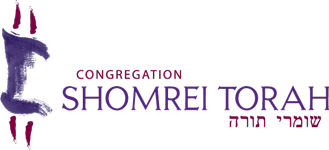October 19, 2011
Simchat Torah is the last of the fall holidays arriving at the end of Sukkot. The name of this holiday means “Joy of the Torah,” and it marks the completion of the year long cycle of reading the Torah. Since we must never finish the Torah reading, the first portion of Genesis is immediately read, starting the Torah reading for the coming year.
Before each Torah is opened, the congregation rises and recites:
Chah-zahk, cha-zahk, v’ni’cha-zahk.
Be strong, be strong, and let us strengthen each other.
How is it celebrated?
Simchat Torah is celebrated with singing, dancing, good food and drink at the synagogue. There is no home observance. At an evening service, all the Torah scrolls are removed from the ark and paraded around the sanctuary in seven circles or hakafot. Many congregations liven up the celebration with music and dancing as they circle with the Torahs. Children participate by carrying flags and miniature Torahs. Carrying the Torah during the procession is an honor often shared by all who are present. Some temples unroll the entire scroll in a huge circle, with people carefully holding the parchment.
Is there a traditional worship service?
Yes, in addition to the procession there is a service with a Torah reading which takes place under a wedding canopy or huppah. The reader of the last portion of Deuteronomy which finishes the scroll and the reader of the first chapters of Genesis are called the bride (kallah) and groom (hatan) of the Torah.
What is consecration?
In some temples, children entering religious school are consecrated or welcomed into the community with a simple ceremony and the gift of a small tallit or prayer shawl, or a small Torah scroll. The rabbi may call the children up to the ark for a special blessing. Simchat Torah ends the more than three weeks of the fall holiday season with a joy that feeds our souls with Jewish energy. That will be sustained each week by Shabbat ceremonies.
